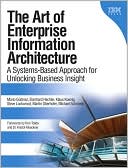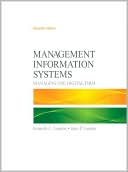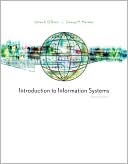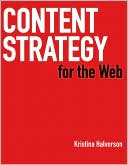The Art of Enterprise Information Architecture: A Systems-Based Approach for Unlocking Business Insight
Search in google:
Architecture for the Intelligent Enterprise: Powerful New Ways to Maximize the Real-time Value of InformationTomorrow’s winning “Intelligent Enterprises” will bring together far more diverse sources of data, analyze it in more powerful ways, and deliver immediate insight to decision-makers throughout the organization. Today, however, most companies fail to apply the information they already have, while struggling with the complexity and costs of their existing information environments.In this book, a team of IBM’s leading information management experts guide you on a journey that will take you from where you are today toward becoming an “Intelligent Enterprise.”Drawing on their extensive experience working with enterprise clients, the authors present a new, information-centric approach to architecture and powerful new models that will benefit any organization. Using these strategies and models, companies can systematically unlock the business value of information by delivering actionable, real-time information in context to enable better decision-making throughout the enterprise–from the “shop floor” to the “top floor.”Coverage Includes Highlighting the importance of Dynamic Warehousing Defining your Enterprise Information Architecture from conceptual, logical, component, and operational views Using information architecture principles to integrate and rationalize your IT investments, from Cloud Computing to Information Service Lifecycle Management Applying enterprise Master Data Management (MDM) to bolster business functions, ranging from compliance and risk management to marketing and product management Implementing more effective business intelligence and business performance optimization, governance, and security systems and processes Understanding “Information as a Service” and “Info 2.0,” the information delivery side of Web 2.0
Foreword by Ron Tolido xixForeword by Dr. Kristof Kloeckner xxiPreface xxiiiAcknowledgments xxixAbout the Authors xxxiChapter 1 The Imperative for a New Approach to Information Architecture 11.1 External Forces: A New World of Volume, Variety, and Velocity 31.1.1 An Increasing Volume of Information 31.1.2 An Increasing Variety of Information 41.1.3 An Increasing Velocity of Information 41.2 Internal Information Environment Challenges 51.3 The Need for a New Enterprise Information Architecture 51.3.1 Leading the Transition to a Smarter Planet 61.4 The Business Vision for the Information-Enabled Enterprise 71.5 Building an Enterprise Information Strategy and the Information Agenda 121.5.1 Enterprise Information Strategy 131.5.2 Organizational Readiness and Information Governance 151.5.3 Information Infrastructure 161.5.4 Information Agenda Blueprint and Roadmap 171.6 Best Practices in Driving Enterprise Information Planning Success 191.6.1 Aligning the Information Agenda with Business Objectives 191.6.2 Getting Started Smartly 191.6.3 Maintaining Momentum 201.6.4 Implementing the Information Agenda 201.7 Relationship to Other Key Industry and IBM Concepts 201.8 The Roles of Business Strategy and Technology 221.9 References 22Chapter 2 Introducing Enterprise Information Architecture 232.1 Terminology and Definitions 232.1.1 Enterprise Architecture 252.1.2 Conceptual Approach to EAI Reference Architecture 272.2 Methods and Models 362.2.1 Architecture Methodology 362.2.2 Information Maturity Model 382.3 Enterprise Information Architecture Reference Architecture in Context 412.3.1 Information On Demand 412.3.2 Information Agenda Approach 422.3.3 The Open Group Architecture Framework 442.3.4 Service-Oriented Architecture and Information as a Service 472.4 Conclusion 502.5 References 51Chapter 3 Data Domains, Information Governance, and Information Security 533.1 Terminology and Definitions 533.2 Data Domains 553.2.1 Classification Criteria of the Conceptual Data Model 563.2.2 The Five Data Domains 603.2.3 Information Reference Model 633.3 IT Governance and Information Governance 643.4 Information Security and Information Privacy 673.4.1 Information Security 673.4.2 Information Privacy: The Increasing Need for Data Masking 703.5 System Context Diagram 743.7 References 74Chapter 4 Enterprise Information Architecture: A Conceptual and Logical View 774.1 Conceptual Architecture Overview 774.1.1 Metadata Management Capability 794.1.2 Master Data Management Capability 794.1.3 Data Management Capability 804.1.4 Enterprise Content Management Capability 804.1.5 Analytical Applications Capability 814.1.6 Business Performance Management Capability 824.1.7 Enterprise Information Integration Capability 824.1.8 Mashup Capability 854.1.9 Information Governance Capability 854.1.10 Information Security and Information Privacy Capability 864.1.11 Cloud Computing Capability 864.2 EIA Reference Architecture–Architecture Overview Diagram 884.3 Architecture Principles for the EIA 904.4 Logical View of the EIA Reference Architecture 984.4.1 IT Services & Compliance Management Services Layer 994.4.2 Enterprise Information Integration Services 994.4.3 Information Services 994.4.4 Presentation Services and Delivery Channels 1014.4.5 Information Security and Information Privacy 1014.4.6 Connectivity and Interoperability 1014.4.7 Business Process Orchestration and Collaboration 1014.5 Conclusion 1024.6 References 102Chapter 5 Enterprise Information Architecture: Component Model 1035.1 The Component Model 1035.2 Component Relationship Diagram 1055.3 Component Description 1055.3.1 Delivery Channels and External Data Providers 1065.3.2 Infrastructure Security Component 1085.3.3 Presentation Services 1095.3.4 Service Registry and Repository 1125.3.5 Business Process Services 1125.3.6 Collaboration Services 1135.3.7 Connectivity and Interoperability Services 1135.3.8 Directory and Security Services 1145.3.9 Operational Applications 1145.3.10 Mashup Hub 1165.3.11 Metadata Management Component and Metadata Services 1195.3.12 Master Data Management Component and MDM Services 1215.3.13 Data Management Component and Data Services 1245.3.14 Enterprise Content Management Component and Content Services 1295.3.15 Analytical Applications Component and Analytical Services 1315.3.16 Enterprise Information Integration Component and EII Services 1345.3.17 IT Service & Compliance Management Services 1385.4 Component Interaction Diagrams–A Deployment Scenario 1395.4.1 Business Context 1395.4.2 Component Interaction Diagram 1415.4.3 Alternatives and Extensions 1445.5 Conclusion 1445.6 References 144Chapter 6 Enterprise Information Architecture: Operational Model 1476.1 Terminology and Definitions 1476.1.1 Definition of Operational Model Levels 1486.1.2 Terms of Operational Aspect 1496.1.3 Key Design Concepts within Operational Modeling 1496.2 Context of Operational Model Design Techniques 1506.3 Service Qualities 1526.3.1 Example of Operational Service Qualities 1526.3.2 Relevance of Service Qualities per Data Domain 1556.4 Standards Used for the Operational Model Relationship Diagram 1556.4.1 Basic Location Types 1556.4.2 Inter-Location Border Types 1586.4.3 Access Mechanisms 1586.4.4 Standards of Specified Nodes 1586.4.5 Logical Operational Model Relationship Diagram 1676.5 Framework of Operational Patterns 1686.5.1 The Context of Operational Patterns 1696.5.2 Near-Real-Time Business Intelligence Pattern 1696.5.3 Data Integration and Aggregation Runtime Pattern 1756.5.4 ESB Runtime for Guaranteed Data Delivery Pattern 1766.5.5 Continuous Availability and Resiliency Pattern 1796.5.6 Multi-Tier High Availability for Critical Data Pattern 1816.5.7 Content Resource Manager Service Availability Pattern 1846.5.8 Federated Metadata Pattern 1856.5.9 Mashup Runtime and Security Pattern 1866.5.10 Compliance and Dependency Management for Operational Risk Pattern 1876.5.11 Retention Management Pattern 1896.5.12 Encryption and Data Protection Pattern 1916.5.13 File System Virtualization Pattern 1946.5.14 Storage Pool Virtualization Pattern 1956.5.15 Automated Capacity and Provisioning Management Pattern 1956.6 Conclusion 1986.7 References 198Chapter 7 New Delivery Models: Cloud Computing 2017.1 Definitions and Terms 2017.2 Cloud Computing as Convergence of IT Principles 2027.2.1 Key Drivers to Cloud Computing 2037.2.2 Evolution to Cloud Computing 2047.3 Cloud Computing as a New Paradigm 2057.3.1 Typical Service Layers in Cloud Computing 2057.3.2 The Nature of Cloud Computing Environments 2077.4 Implication of Cloud Computing to Enterprise Information Services 2097.4.1 Multi-Tenancy 2097.4.2 Relevant Capabilities of EIS in a Cloud Environment 2147.5 Cloud Computing–Architecture and Services Exploration 2157.6 Business Scenario with Cloud Computing 2167.6.1 Business Context 2167.6.2 Component Interaction Diagram 2177.7 Conclusion 2217.8 References 221Chapter 8 Enterprise Information Integration 2238.1 Enterprise Information Integration–Terms, History, and Scope 2238.2 Discover 2248.2.1 Discover Capabilities 2248.2.2 Discover Scenario 2278.3 Profile 2288.3.1 Profile Capabilities 2288.3.2 Profile Scenario 2308.4 Cleanse 2328.4.1 Cleanse Capabilities 2328.4.2 Cleanse Scenario 2358.5 Transform 2368.5.1 Transform Capabilities 2368.5.2 Transform Scenario 2378.6 Replicate 2398.6.1 Replicate Capabilities 2398.6.2 Replication Scenario 2428.7 Federate 2448.7.1 Federate Capabilities 2448.7.2 Federation Scenario 2468.8 Data Streaming 2478.8.1 Data Streaming Capabilities 2478.8.2 Data Streaming Scenario 2518.9 Deploy 2538.9.1 Deploy Capabilities 2538.9.2 Deploy Scenario 2548.10 Conclusion 2568.11 References 256Chapter 9 Intelligent Utility Networks 2579.1 Business Scenarios and Use Cases of the IUN 2589.1.1 Increasing Issues Concerning Electrical Energy 2589.1.2 The Demand for New Business Models 2599.1.3 Typical Use Cases 2619.2 Architecture Overview Diagram 2639.3 The Logical Component Model of the IUN 2659.3.1 Power Grid Infrastructure 2669.3.2 Data Transport Network and Communication 2669.3.3 Enterprise Information Integration (EII) Services 2679.3.4 Remote Meter Management and Access Services 2689.3.5 Automated Billing and Meter Data Management 2689.3.6 Enterprise Asset Management 2689.3.7 Work Order Entry Component and Mobile Workforce Management 2689.3.8 Customer Information and Insight with Portal Services 2699.3.9 Outage Management System 2699.3.10 Predictive and Advanced Analytical Services 2699.3.11 Geographic Information System (GIS) 2709.4 Component Interaction Diagram 2709.4.1 Component Interaction Diagram: Smart Metering and Data Integration 2719.4.2 Component Interaction Diagram: Asset and Location Mashup Services 2729.4.3 Component Interaction Diagram: PDA Data Replication Services 2739.5 Service Qualities for IUN Solutions 2749.5.1 Functional Service Qualities 2749.5.2 Operational Service Qualities 2759.5.3 Security Management Qualities 2759.5.4 Maintainability Qualities 2769.6 Applicable Operational Patterns 2779.7 Conclusion 2789.8 References 279Chapter 10 Enterprise Metadata Management 28110.1 Metadata Usage Maturity Levels 28110.2 Terminology and Definitions 28210.2.1 EIA Metadata Definition 28310.2.2 What Is Metadata Management? 28710.2.3 End-to-End Metadata Management 28910.3 Business Scenarios 28910.3.1 Business Patterns 28910.3.2 Use Case Scenarios 29010.4 Component Deep Dive 29110.4.1 Component Model Introduction 29110.4.2 Component Descriptions 29210.4.3 Component Relationship Diagrams 29310.5 Component Interaction Diagram–Deployment Scenario 29410.5.1 Business Context 29510.5.2 Component Interaction Diagram 29510.6 Service Qualities for Metadata Management 29810.7 Applicable Operational Patterns 30010.8 IBM Technology Mapping 30210.8.1 IBM Technology Overview 30210.8.2 Scenario Description Using IBM Technology 30310.9 Conclusion 30510.10 References 306Chapter 11 Master Data Management 30711.1 Introduction and Terminology 30711.1.1 Registry Implementation Style 30811.1.2 Coexistence Implementation Style 30911.1.3 Transactional Hub Implementation Style 30911.1.4 Comparison of the Implementation Styles 31011.1.5 Importance of Information Governance for MDM 31111.2 Business Scenarios 31111.3 Component Deep Dive 31311.3.1 Interface Services 31411.3.2 Lifecycle Management 31411.3.3 Hierarchy and Relationship Management Services 31511.3.4 MDM Event Management Services 31611.3.5 Authoring Services 31611.3.6 Data Quality Management Services 31611.3.7 Base Services 31711.4 Component Interaction Diagram 31811.5 Service Qualities 32311.5.1 MDM Security 32311.5.2 Privacy 32511.6 Applicable Operational Patterns 32611.7 Conclusion 32711.8 References 328Chapter 12 Information Delivery in a Web 2.0 World 32912.1 Web 2.0 Introduction to Mashups 32912.2 Business Drivers 33012.2.1 Information Governance and Architectural Considerations for Mashups 33512.3 Architecture Overview Diagram 33612.4 Component Model Diagram 33812.5 Component Interaction Diagrams 34012.5.1 Component Interaction Diagrams–Deployment Scenarios 34312.6 Service Qualities for Mashup Solutions 34512.7 Mashup Deployment–Applicable Operational Patterns 34912.7.1 Scenario 1: Simple Deployment Model 34912.7.2 Scenario 2: High Availability Model 35012.7.3 Scenario 3: Near-Real-Time Model 35312.8 IBM Technologies 35412.8.1 Lotus Mashups 35512.8.2 InfoSphere Mashup Hub 35512.8.3 WebSphere sMash 35512.9 Conclusion 35612.10 References 357Chapter 13 Dynamic Warehousing 35913.1 Infrastructure for Dynamic Warehousing 36013.1.1 Dynamic Warehousing: Extending the Traditional Data Warehouse Approach 36113.2 Business Scenarios and Patterns 37013.2.1 Practical Business Applications 37113.3 Component Interaction Diagrams–Deployment Scenarios 37213.3.1 Dynamic Pricing in the Financial Industry 37213.3.2 Addressing Customer Attrition/Churn 37713.4 Conclusion 38113.5 References 381Chapter 14 New Trends in Business Analytics and Optimization 38314.1 A New Approach to Business Performance Management 38414.1.1 A Framework for Business Analytics and Business Optimization 38514.1.2 Performance Metrics 38714.2 Business Scenario, Business Patterns, and Use Case 38714.2.1 Banking Use Case 38814.3 Component Interaction Diagrams–Deployment Scenarios 38914.3.1 Predictive Analytics in Health Care 39014.3.2 Optimizing Decisions in Banking and Financial Services–Trading 39414.3.3 Improved ERM for Banking and Financial Services 39714.4 Conclusion 40214.5 References 403Glossary 405Index 415Appendixes can be found online at www.ibmpressbooks.com/artofeiaAppendix A: Software Product Mapping 1Appendix B: Standards and Specifications 19Appendix C: Regulations 33








